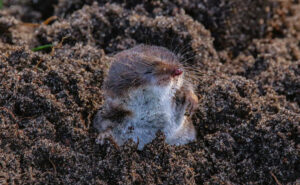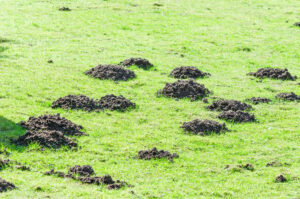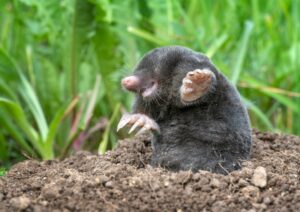
Moles are small, burrowing creatures that can wreak havoc on your lawn and garden. They have long, pointed snouts, velvety fur, and tiny eyes and ears. While they don’t pose a direct threat to humans or pets, their digging can damage plants and create unsightly mounds of soil. If you’ve noticed raised ridges, tunnels, and mounds of soil in your lawn or garden, you might be dealing with moles. These small, furry creatures are insectivores that spend their time burrowing through the soil in search of food.
While moles may seem harmless, their digging can cause serious damage to your yard and garden. In Part 1 of this article, we’ll focus on understanding the nature of moles and why they are a problem to your lawn.
What Are Moles?
Moles come in various sizes and colors but share some physical characteristics. They have short, powerful legs and broad, spade-like feet that help them dig through soil. Their fur is thick and velvety, which allows them to move easily through tunnels. There are several species of moles, including the Eastern Mole, the Star-Nosed Mole, and the Coast Mole, each of which has its own unique characteristics.
Moles are burrowing animals, which means they spend most of their time underground. They dig tunnels to create a network of pathways that they use to find food and shelter. They can dig through soil quickly and efficiently, allowing them to move through the earth at a rapid pace.
Signs of Moles in Your Garden
One of the most obvious signs of moles in your yard or garden is the presence of raised ridges and mounds of soil. These are created when moles dig tunnels just below the soil’s surface. You may also notice small, round holes where moles have dug to the surface.
It’s important to note that not all damage to your lawn or garden is caused by moles. Other pests like voles and gophers can also cause similar damage. To determine if moles are the culprit, look for the distinctive mole tunnels and mounds of soil.
Understanding Mole Behavior
Moles are insectivores, which means they eat insects and other small creatures. They use their keen sense of smell to locate their prey and their powerful front legs and teeth to catch and kill it. Moles are active day and night and spend most of their time digging tunnels and searching for food.
Moles are solitary animals that typically do not interact with other moles except during the breeding season. Mating occurs in the spring; females birth to litters of three to five pups. Moles have a relatively short lifespan; most live only two to three years.
Why Moles Can Be a Problem
While moles may seem harmless, their digging can cause serious damage to your yard and garden. As they burrow through the soil, they can disrupt plant roots and create air pockets that dry out the soil. The mounds of soil they create can also be unsightly, making it difficult to mow your lawn.
Conclusion
Moles can be a nuisance in your yard and garden if not taken care of. Understanding their behavior and signs of their presence is essential in eliminating them. In the next part of this article, we will explore effective ways to get rid of moles and prevent them from coming back.
Trap Your Moles are the best mole-trapping pros in the Cincinnati, Dayton, Springfield, Indiana, Wilmington, and Northern KY areas. If you’re looking for the best mole trapping pros in Dayton, we can help you! Call us today for a free consultation!







No comment yet, add your voice below!